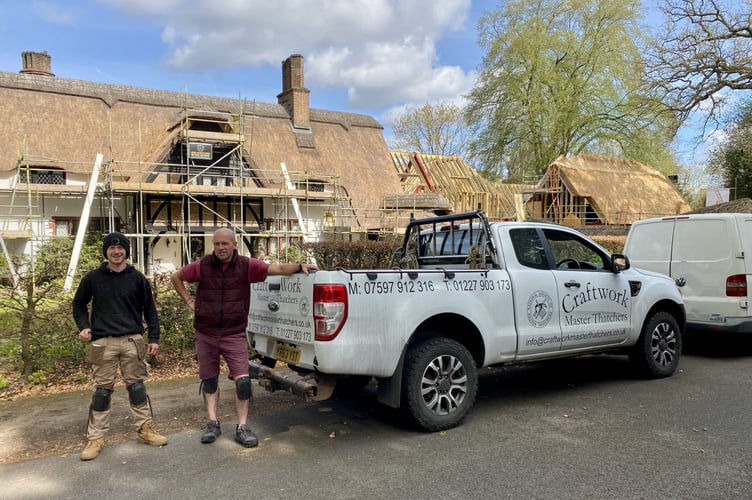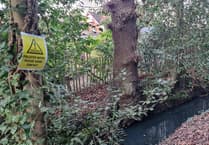Following a Lead
Just sometimes someone will approach me with a suggestion for a piece for this page. The other day Philip, a friend who tells me he lives in Upper Horsell, found himself following a load of thatching straw and thought it could be the base of a story for me.
He was driving along Littlewick Road bound for Byfleet for a rehearsal when he found himself behind a pick-up truck loaded with what he, at first thought, was hay and then realised it was straw.
This load intrigued him and it was going in his direction so he followed it. Over the Six Crossroads roundabout and on to Sheerwater Road.
At that point I interrupted him: “It turned into Old Avenue, didn't it!”
“How did you know that?”
“I know because the master thatcher in charge of the thatching job in that road is currently staying with me!”
Ben Rance lived in this area for some time and we have known him for some 30 years, he being part of the group which included my daughters.
He eventually moved to Kent, where he was born and raised, and he duly qualified from Europe’s only thatching academy, Knuston Hall, in Northants, where he served the full traditional apprenticeship.
But when a thatching job in this part of the world comes up he and his apprentice stay with me for the duration of the job.
He formed BRSA Master Thatchers in Surrey in 2008 and throughout his thatching career has worked alongside many established and respected master thatchers.
He has worked throughout the East Coast of America, on several TV and film sets and exhibitions, in addition to thatching on a wide spectrum of domestic and commercial roofs. He prides himself on the high standards he sets himself and enjoys applying his own artistic flair to time-tested traditional thatching methods.
Although he relocated to his home county of Kent, where he set up Craftwork Master Thatchers, he finds plenty of work beyond that county. People do not think of this Surrey area as being littered with thatched dwellings but there are a surprising number around.
And what attracted Ben to thatching? A book he read as a child which was illustrated with pictures of thatched houses – he was captivated by them and this is why, many years later, a waggon-load of thatching straw caught the eye of the man from Upper Horsell.
Does this neighbour therefore suggest I live in Lower or Mid Horsell? Where does he reckon the boundaries are drawn?
Obviously a hot topic for another piece on this page in the future.
Follow That!
I did!
It was some years ago and I was being driven through London late in the evening when I uttered the phrase, uncommon in that place and on ground level – to Follow That Plane!
Which we duly did.
It was a Formula I racing aircraft, towed by my old friend Fred Marsh, who was taking it to a site for a forthcoming air race.
Unfortunately, being a Formula I aircraft, it was a single seater and so I never got airborne in what he named Pie in the Sky – his day job was as a very successful a producer of pies, sausages and so on in Cambridge.
Who Were They?
Casting his eye over the obituaries in the newspaper my late husband would often comment, “Why didn't we know about them when they were alive?”
In every community there are men and women, and in some cases, children, who go above and beyond the rest to contribute to the community. These people often go through life without a huge amount of recognition and, in most cases, are neither rich nor famous.
An exhibition, presented by Send & Ripley History Society and entitled Community Heroes – Stories from Village Life, focuses on two such people: wartime pharmacist extraordinaire Kenneth White and his assistant, John Hutson.
Some time ago the society erected a blue plaque to Kenneth: “In this former pharmacy Kenneth White made the first penicillin for civilian use during WWII at these premisses 1943-1951” in tribute to Ken, who passed away at home on 29 March this year aged 94.
The society comments that it could have featured many more community heroes – some who have died but plenty who are still adding to the richness of Send and Ripley today.
The museum says: “The first person is remembered because he managed to make penicillin for civilians when it was restricted to the military; the second because without him the amazing archive from the Ripley chemist’s shop would not have been saved.”
The exhibition is open until the end of June, every Saturday between 10am and noon or by appointment: contact Clare on 01483 728546. The museum is next to Ripley Village Hall.
May UnFayre
I was talking with one of the organisers of the Horsell Scouts and Guides Grand May Fayre, which will take place on Bank Holiday Monday, 5 May on the Wheatsheaf Recreation Ground.
Things do not get any easier for the organisers: it would seem the main problems are down to paperwork and form filling.
Everything has to be covered by insurance. The public loos will still be shut. There is paperwork to be filed for vehicles, stalls, health and safety – but not much can be done about the weather.
When one looks back on last year's Glastonbury mud-type May Fayre, and count the number of local events which were cancelled or, at least, postponed, due to adverse weather fingers must be very firmly crossed.
But the Fayre Will Go On – of course it will, this is Horsell Scouts and Guides of which we speak – they will make it happen come hell or high water (and possibly both of those).
So please get along to the Wheatsheaf and give encouragement – and money.
I have heard that we are now in the paperless society – try telling that to the fayre organisers.
Hairy Moment
When I was first diagnosed with cancer I wondered whether I would lose my hair. If I did, would I look as good as my eldest daughter when she shaved her head in aid of Children in Need?
Although there were times when I thought my hairbrush was looking overloaded the family said they had noticed nothing untoward. And I still have hair on my head.
If I had lost my hair, would people still recognise me? I used to get mistaken for a lady at church who wore her blonde hair in a neat chignon.
That is how people knew I was not me – my hair is rarely neat.
There was the time when, for a long-forgotten reason, I had a wig with me and was due to meet a boyfriend at a railway station. I popped the wig on and sauntered up to him, enquiring whether he would like to have a “good time” with me.
He snorted and turned me away, not having recognised me in the wig. If he had accepted the offer I might have hit him.
A male friend, whom I have known for many years and who wears a beard and his hair long and tied back, turned up without the hairband.
I found it interesting that he automatically tossed his long hair just as a woman might.
He said he was going to get a haircut and I wondered whether I would recognise him with a short back and sides and no beard. He was only thinking of a slight trim but it did set me wondering: there are so many hirsute men around these days and they would all look so totally different clean shaven.
Some time ago I lunched at The Cricketers in Horsell. The majority of the tables appeared to have been taken by pairs of ladies.
We were sitting so that my friend had his back to the servery. My friend is in his 90s and has a magnificent head of white hair – and a beard.
The waiter, approaching from behind my friend, asked “and what would you ladies like to eat?”
To the waiter's horror my friend turned his bearded face to him. Anxious to soothe the moment I told the waiter he was in luck for this was one of the last bearded ladies in Surrey and so after a bit of a mutual giggle, we duly ordered.

.jpeg?width=209&height=140&crop=209:145,smart&quality=75)

